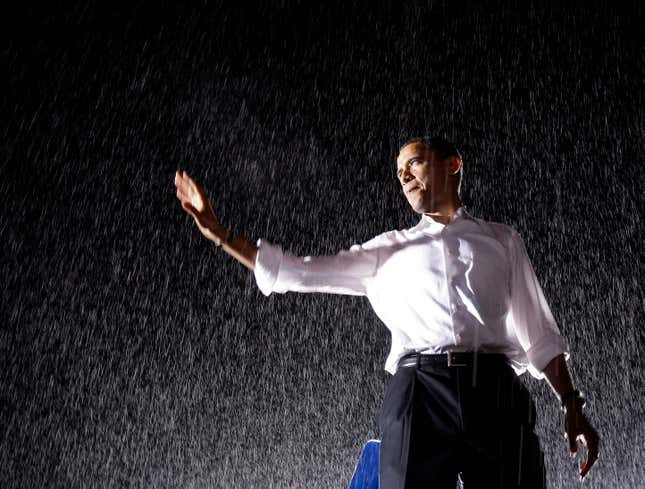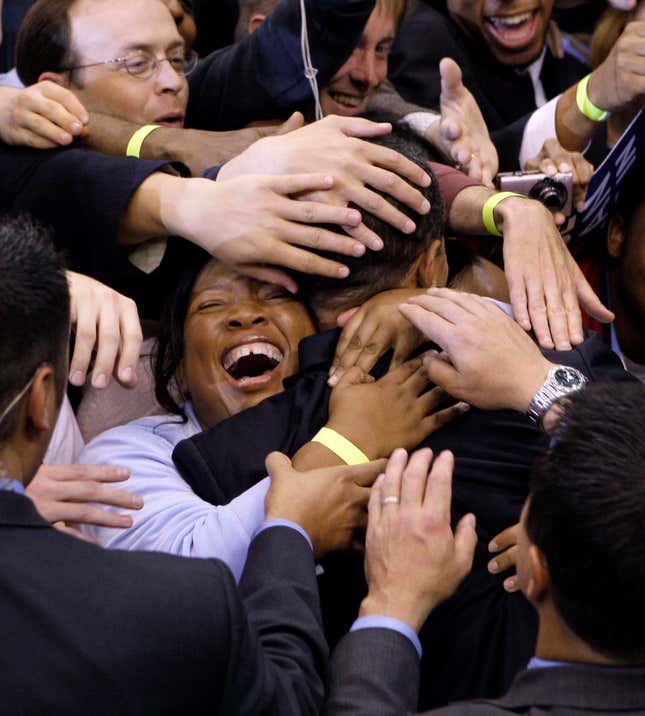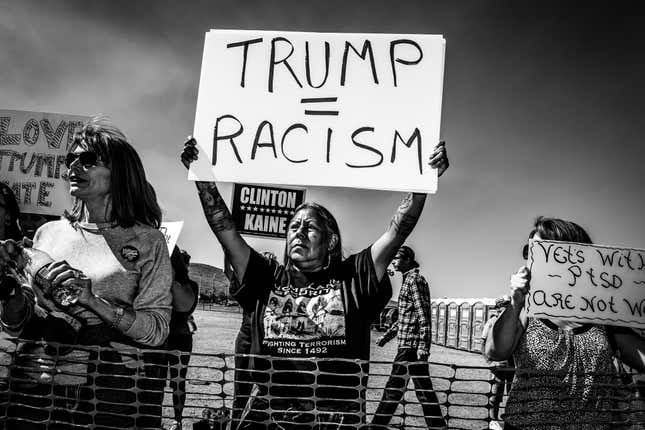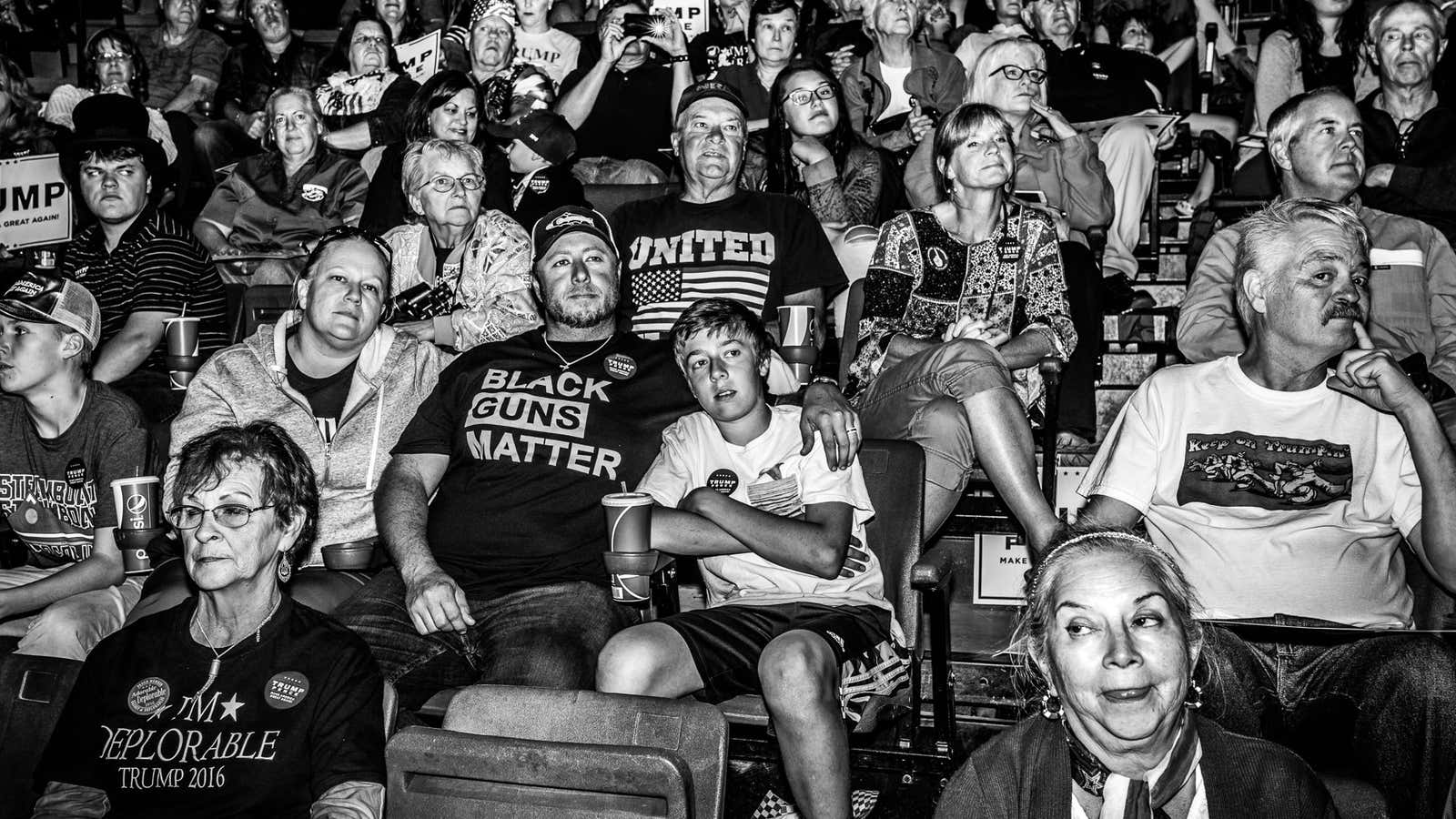If 2008 was an election of hope, 2016 is bound to go down as the election of fear. For most, anxieties about the candidates, the nation, and even our neighbors’ political views have made the presidential race a fretful slog.
To match the tone of the campaign trail, many photographers have adopted a distinct and unusually harsh style: Aggressively lit with direct flash, their images are heavily toned in black and white and frequently seem unflattering, even grotesque. Contrast that to photos from the 2008 election, when gentler lighting conveyed heroism and history, and emphasis lay on emotional reactions.


One viral photo from this year’s campaign cycle shows an attentive, all-white crowd at a rally for Donald Trump in Loveland, Colorado. Shot by Seattle-based photographer Nate Gowdy, the stark black-and-white image prompted outspoken reactions, including criticism of a shirt in the foreground that seemed to advertise a gun-advocacy group called Black Guns Matter.
This image captures the style of photography that has defined the year’s political coverage. The tones are deeply contrasted. Subjects are blanketed with the glow of Gowdy’s flash, instead of ambient light. This strong light creates a direct connection between the people photographed and the photographer; instead of merely documenting the scene as it is, Gowdy makes his presence known with a blinding light.
“I want folks to see what’s there,” Gowdy said through email. “Just raw, flawed human beings. I want to portray real people and not airbrushed visions.” He describes the striking black and white contrast as reflective of ”the harsh contrast of a passionately partisan contest, as well as the blunt ways supporters see themselves and their rivals.”
“The monochromatic medium symbolizes the history of the timeless American experiment, still ongoing, with less and less room for gray,” he adds.

Nate’s heavily-stylized work rests far outside the norms of wire services such as Getty Images or the Associated Press. But he’s hardly alone. Many others have also subverted expectations of what a “political” photo can be, by injecting extreme drama, humor and conflict into the frame through strong flash and dramatic composition.
With work appearing in the New Yorker, New York Magazine and MSNBC, acclaimed photographer Mark Peterson created some of the wildest images from the campaign season.
https://www.instagram.com/p/BEbenlzmMcS/
Photographer Landon Nordeman has taken a boldly colorful approach—more familiar to the fashion world—and applied it to the boisterous pageantry of the election cycle.
https://www.instagram.com/p/BGZVc3RqRKt/
M. Scott Brauer, a photographer who shot more than a dozen presidential wannabes this year, sees this year’s high-contrast style as a way to probe candidates visually. “Journalists are supposed to question and investigate,” he writes in an email, “but if we photograph these candidates on nice stages with beautiful lights, it’s just like printing press releases and does a disservice to the viewers.”
“I don’t mean it as a critique of a particular candidate or party,” he adds, explaining that he’s more interested in the stagecraft and spectacle than the politicians themselves.
There are practical reasons for this year’s style: Aside from massive rallies with professional stage lighting, a lot of early campaigning is done in dimly lit diners, bowling alleys and community meeting halls. When Brauer began taking pictures in New Hampshire before the primaries, he was nursing a broken arm and couldn’t hire an assistant to carry his gear. Firing off a strobe light was a simple way to photograph candidates across venues, without losing consistency.
In a deeply polarizing presidential race, a strong flash tends to convey a strong point of view from the photographer. But that doesn’t mean the photographers covering this race are taking sides: Brauer’s body of work, which features a sprawling bipartisan cast, is simply titled, “This Is The Worst Party I’ve Ever Been To.”
